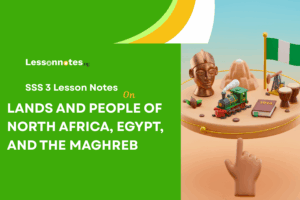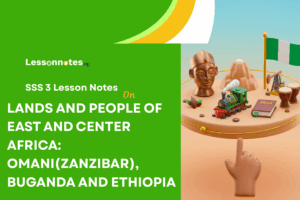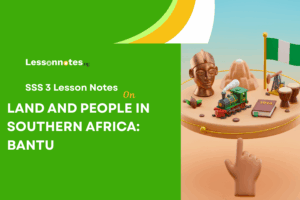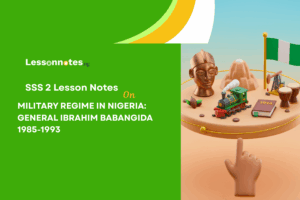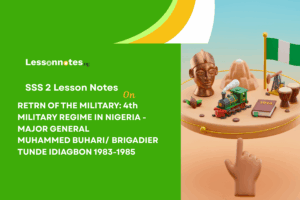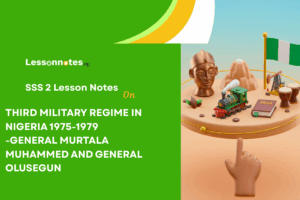OYO SS1 Nigerian History Lesson Note
Download Lesson NoteTopic: OYO

The Oyo Empire was one of the most powerful and important kingdoms in West Africa. It was a Yoruba state located in what is now southwestern Nigeria and parts of the Republic of Benin. At its peak, the Oyo Empire controlled a vast territory and influenced many neighboring states. This lesson explores how the empire began, how it was governed, its economy, and why it eventually fell.
Origins and Early History
Foundation of the Empire
The Oyo Empire had deep connections to Yoruba history:
- Originated from Ile-Ife, the sacred city of the Yoruba people
- Founded by Oranmiyan, a prince from Ile-Ife
- Oranmiyan was said to be a grandson of Oduduwa, the legendary ancestor of all Yoruba
- The first settlement was at Old Oyo (Oyo-Ile)
- Located in the savannah region north of the forest zone
- This location allowed access to trade routes and good farmland
- Early kings faced challenges establishing the kingdom
- Legend says Oranmiyan left Oyo and later his son Ajaka became the first Alaafin
- The term “Alaafin” means “owner of the palace” in Yoruba language
- The exact date of foundation is unclear but likely around the 14th century
Growth and Expansion
The Oyo Empire gradually grew in power and size:
- By the late 15th century, Oyo’s influence had spread to most parts of Yorubaland
- Under Alaafin Obalokun, Oyo began significant expansion
- The empire reached its greatest extent in the 17th and 18th centuries
- At its peak, stretched from the Niger River in the east to the Volta River in the west
- Controlled much of what is now southwestern Nigeria and the Republic of Benin
- Dominated trade routes between the forest and savannah regions
- Incorporated many Yoruba and non-Yoruba peoples
- Established tributary relationships with conquered territories
- Built a strong military that included cavalry (horsemen)
- Created a sophisticated administrative system to govern this large area
Socio-Political Organization
The Alaafin (King)
At the head of the Oyo Empire was the supreme ruler:
- Called the Alaafin, meaning “owner of the palace”
- Considered semi-divine and sacred
- Lived in a large palace complex in Oyo-Ile
- Had many wives who played important political roles
- Wore elaborate regalia including beaded crowns
- Communicated with subjects through palace officials
- Could not be seen eating or showing strong emotions in public
- Controlled royal treasuries and trade
- Commander-in-chief of the army
- Symbol of Oyo unity and power
- The position was hereditary within the royal lineage
The Aremo
The Alaafin’s first son had a special position:
- Called the Aremo
- Enjoyed royal privileges during his father’s lifetime
- Helped the Alaafin in administration
- Traditionally required to commit suicide when his father died
- This practice prevented succession disputes
- Ensured peaceful transitions of power
- Later this practice was abandoned
- The Aremo was not automatically the next Alaafin
- Lived in his own section of the palace
- Represented the Alaafin at some functions
The Oyo Mesi
A powerful council balanced the Alaafin’s authority:
- Consisted of seven high chiefs (Iwarefa)
- Selected the Alaafin from candidates of the royal family
- Could force a tyrannical Alaafin to commit suicide
- Led by the Bashorun (Prime Minister)
- Met regularly to discuss affairs of state
- Represented different interests in the empire
- Members had specific responsibilities
- Provided checks and balances on royal power
- Their consent was needed for major decisions
- Helped ensure stable government
Key Members of the Oyo Mesi
The council had seven members with specific duties:
- Bashorun – the head of the Oyo Mesi
- Most powerful chief after the Alaafin
- Could declare the Alaafin unfit to rule
- Led the council of chiefs
- Consulted the Ifa oracle on important matters
- Acted as regent when there was no Alaafin
- Agbakin – second in command to the Bashorun
- Assisted the Bashorun in his duties
- Had specific ceremonial roles
- Represented certain community interests
- Samu – responsible for the treasury
- Managed the empire’s finances
- Collected taxes and tributes
- Advised on economic matters
- Laguna – had military responsibilities
- Coordinated with the Are-Ona-Kakanfo
- Involved in defense planning
- Represented military interests in the council
- Akinniku – responsible for palace administration
- Managed the Alaafin’s household
- Oversaw palace officials
- Coordinated palace ceremonies
- Asipa – helped maintain public order
- Had policing responsibilities
- Resolved certain types of disputes
- Enforced council decisions
- Ona Efa – Chief Justice
- Administered justice
- Interpreted laws
- Settled major disputes
- Advised on legal matters
Other Important Officials
Beyond the Oyo Mesi, other officials had crucial roles:
- Otun Efa – chief priest of Sango (deity of thunder)
- Conducted important religious ceremonies
- Maintained the Sango shrine
- Advised on religious matters
- Interpreted omens and signs
- Osi Efa – Minister of Finance
- Worked with the Samu on financial matters
- Managed trade regulations
- Collected market taxes
- Supervised royal trading ventures
- Oluwo – head of the Ogboni cult
- Led the secret society of elders
- Had authority over the Bashorun in some matters
- Conducted earth rituals
- Represented ancestral authority
- Helped maintain balance of power
The Military System
Oyo’s army was a key to its power:
- Headed by the Are-Ona-Kakanfo (Generalissimo)
- The Are-Ona-Kakanfo could not live in the capital
- Expected to either win in battle or die trying
- Never to return defeated from war
- Often the position was given to someone from a provincial area
- The army included cavalry (horsemen) which was rare in forest kingdoms
- Horses were imported from the north
- Infantry (foot soldiers) formed the majority of troops
- Provincial forces supplemented the central army
- Military success brought wealth through tribute and slaves
- Oyo’s military power allowed it to dominate neighbors
Social Structure
Oyo society was organized in clear layers:
- Royal family at the top
- Chiefs and nobles formed the upper class
- Priests and religious leaders had special status
- Free citizens formed the middle layers
- Traders and craftspeople had their own organizations
- Farmers made up the majority of the population
- Slaves were at the bottom of society
- Social mobility was possible through military service or trade
- Age-grade associations organized people by generation
- Women played important economic roles despite limited political power
Checks and Balances
The Oyo political system prevented abuse of power:
- The Alaafin had supreme authority but was limited by the Oyo Mesi
- The Bashorun could reject the Alaafin’s decisions
- The Oluwo had authority over the Bashorun in some matters
- The Are-Ona-Kakanfo controlled the military but couldn’t live in the capital
- Religious authorities provided spiritual checks
- This complex system created stability
- Prevented any one person from gaining too much power
- Allowed for peaceful resolution of conflicts
- Created a government “devoid of tyranny”
- Helps explain Oyo’s long-term success
The Oyo Economy
Agriculture
Farming was the foundation of daily life:
- The Oyo people were sedentary farmers
- Grew crops like yams, maize, sorghum, and millet
- Palm oil production was important
- Kept livestock including goats, sheep, and chickens
- Used simple tools like hoes and machetes
- Farming techniques passed down through generations
- Surplus food supported the urban population
- Agricultural taxes provided revenue
- Farm products were traded locally and regionally
- Community farming helped during planting and harvest
Trade and Commerce
Oyo became wealthy through extensive trade:
- Strategically located between forest and savannah regions
- Controlled important trade routes
- Regular markets in towns and villages
- Long-distance trade with northern and southern neighbors
- Traded kola nuts, which were valued in the north
- Exported woven cloth, which was famous for its quality
- Imported salt from coastal areas
- Traded in horses from the north
- Developed crafts including woodcarving and metalworking
- Created bronze and brass images
Craft Production
Specialized crafts flourished in Oyo:
- Weaving of cotton and other fibers
- Dyeing using indigo and other natural colors
- Blacksmithing for tools and weapons
- Woodcarving for masks, doors, and religious items
- Leatherworking for shoes, bags, and horse equipment
- Pottery for household and ceremonial use
- Bead making and working
- Calabash decoration
- These crafts were organized in guilds
- Products were both used locally and traded widely
Revenue Sources
The empire collected resources in various ways:
- Taxes on trade and markets
- Tributes from vassal states
- Tolls on trade routes
- Share of war booty
- Agricultural taxes
- Customs duties at borders
- Special levies for projects
- Gifts to the Alaafin
- Labor service for public works
- These revenues supported the government, military, and royal court
The Slave Trade
Human captives became an important trade item:
- Initially traded slaves within Africa
- Later became involved in the transatlantic slave trade
- Oyo warriors captured people in military campaigns
- Some captives were kept as slaves in Oyo
- Others were sold to European traders on the coast
- Received firearms, alcohol, textiles, and other goods in exchange
- This trade brought wealth but had negative effects
- Created dependency on European trade goods
- Changed the focus of warfare
- Contributed to instability in the long term
- Became a factor in Oyo’s eventual decline
The Fall of the Oyo Empire
Beginning of Decline
After a period of great power, problems emerged:
- Decline began after the reign of Alaafin Abiodun (late 18th century)
- Internal power struggles weakened central authority
- Provincial areas became more independent
- The balance of power shifted away from the Alaafin
- Tributary states began to resist paying tribute
- Trade patterns changed with European coastal presence
- The slave trade had destabilizing effects
- Neighboring powers grew stronger
- These problems combined to weaken the once-mighty empire
Weakening of Central Authority
Power struggles undermined effective governance:
- Bashorun Gaha became too powerful
- Forced several Alaafins to commit suicide
- Created political instability and lawlessness
- Alaafin Abiodun eventually defeated Gaha
- But the damage to central authority was lasting
- Officials began to pursue personal interests
- Provinces became more autonomous
- The complex system of checks and balances broke down
- Instead of preventing tyranny, it created paralysis
- Trust in the government system was damaged
Military Problems
The army that had built the empire became a problem:
- Are-Ona-Kakanfo (military leaders) became disloyal
- Some worked against the central government
- Military leaders gained too much independent power
- Provinces built up their own military forces
- The traditional requirement for Are-Ona-Kakanfo to win or die led to desperate actions
- Military resources were strained by constant warfare
- Could no longer effectively control the large territory
- Provincial armies sometimes fought each other
- The military became part of the problem instead of the solution
Afonja’s Rebellion
A key military leader’s actions damaged the empire:
- Afonja was the Are-Ona-Kakanfo based in Ilorin
- Refused to accept the authority of Alaafin Aole
- Declared Ilorin independent from Oyo in 1817
- Invited Fulani Muslim scholars to support him
- These Fulani allies eventually overthrew Afonja
- Ilorin became a Fulani emirate
- Created a dangerous enemy on Oyo’s northeastern border
- Showed other provinces that rebellion was possible
- Further weakened the authority of the Alaafin
- Damaged the unity of the empire
Economic Factors
Financial problems accelerated the decline:
- Loss of trade routes reduced income
- Political instability disrupted markets
- Tribute from vassal states decreased
- The transatlantic slave trade began to decline
- European trade shifted to palm oil and other goods
- Could no longer afford large military campaigns
- The wealth that had sustained the empire diminished
- Poverty increased in some areas
- Economic power shifted to coastal states
- Created a cycle of economic and political weakness
External Attacks
Enemies took advantage of Oyo’s weakness:
- Dahomey (now Benin Republic) stopped paying tribute
- Launched attacks against Oyo territories
- The Egba broke away from Oyo control
- Fulani jihadists attacked from the north
- Ilorin became a base for attacks against Oyo
- Other Yoruba states asserted independence
- The empire lacked the strength to respond effectively
- Lost territories on multiple fronts
- Former vassals became enemies
- The empire shrank rapidly
Final Collapse
The once-great empire came to an end:
- By the 1830s, Oyo had lost most of its territory
- Old Oyo (Oyo-Ile) was abandoned around 1835
- The capital moved south to present-day Oyo town
- The Alaafin became just one of many Yoruba kings
- The empire effectively ceased to exist
- Different parts of the former empire became independent
- Some areas fell under Fulani control
- Others formed new Yoruba kingdoms
- Civil wars erupted among former Oyo territories
- Set the stage for European colonization later in the century
Legacy of the Oyo Empire
Political Legacy
Oyo’s governmental systems influenced later states:
- Many Yoruba kingdoms adopted aspects of Oyo’s political structure
- The balanced government model inspired later constitutions
- Titles and offices continued in modified forms
- The Alaafin still exists today as a traditional ruler
- Concepts of checks and balances remained important
- The idea of limited monarchy influenced Yoruba political thought
- Contemporary Yoruba states maintained connections to Oyo traditions
- Colonial authorities used some Oyo administrative methods
- The legacy of effective governance remained even after the empire fell
- Modern Nigerian politics still shows some influences from these traditions
Cultural Impact
Oyo culture spread widely:
- Oyo dialect became the basis of standard Yoruba language
- Artistic styles influenced wider Yoruba culture
- Religious practices spread throughout Yorubaland
- Music and dance forms were adopted by other groups
- Oyo clothing styles became widespread
- Festivals and ceremonies were copied elsewhere
- Historical memory of Oyo greatness remains strong
- Oral traditions preserved stories of Oyo’s history
- Cultural pride in Oyo achievements continues today
- Many Yoruba people trace their ancestry to Oyo
Historical Significance
Oyo’s place in West African history:
- Demonstrated sophisticated African governance before colonialism
- Showed how balance of power could create stable government
- Illustrated the rise and fall cycle of great empires
- Connected the forest and savannah regions through trade
- Influenced the development of many other states
- Created lasting cultural and linguistic patterns
- Represented a high point of political organization
- Provided a counterpoint to European claims of African “primitiveness”
- Its history helps understand pre-colonial West Africa
- Continues to be studied as an example of African statecraft.




